Recent datasets
64 'key' reefs in 11 sectors of the Great Barrier Reef (Cape Grenville, Princess Charlotte Bay, Cooktown/Lizard Island, Cairns, Innisfail, Townsville, Cape Upstart, Whitsunday, Pompey Complex, Swain and Capricorn Bunker) are annually surveyed for crown-of-thorns starfish using the manta tow technique. An additional 117 reefs from the sectors (excluding the Whitsunday, Swain and Capricorn-Bunker sectors) are scheduled for survey every third year ('cycle' reefs).
Data on the general appearance and condition of coral reefs which have been manta towed in the Long Term Monitoring Project (LTMP). The data from 4 reef zones - front (seaward) and back (leeward), and north and south (flanks 1 and 2) - are used to create a web page on each zone for each reef (http://apps.aims.gov.au/reef-monitoring/).
In 6 sectors of the Great Barrier Reef (Cooktown/Lizard island, Cairns, Townsville, Whitsunday, Swain and Capricorn Bunker) 49 of the key manta tow reefs are designated 'core' survey reefs and are also surveyed using the scuba search technique. Where possible, three or more reefs in each sector have been selected in each of three positions across the continental shelf: inshore, mid-shelf and outer shelf.
This data set contains information on Oil and Gas pipeline infrastructure. This dataset has been converted from Microstation format used in a map "Petroleum Exploration and Development Titles" published annually in APRIL. Attributes have been added to comply with data standards and minor coding of line work has been achieved using annotation from the map. Further data has been added, specifically for the specific Acreage Release Areas.
The AIMS Long-term Monitoring Program (LTMP) is designed to detect changes in reef communities at a subregional scale. In this context, a subregion encompasses inshore, mid-shelf and outer shelf reefs across the continental shelf within one band of latitude (a sector).Reef surveys involve three approaches:1. broadscale manta tow surveys of crown-of-thorns starfish populations and reef-wide coral cover2. Intensive photographic surveys of stationary seafloor (benthic) organisms on fixed transects3.
Water Quality Data from the AIMS Long Term Monitoring Program. Water and sediments (another dataset) were sampled at the same sites adjacent to all 52 reefs where fish and benthic transects are conducted. Sampling occurs in open water within 500 metres of the reef, on both sides (north and south flanks) of the reef. Sampled reefs occur throughout the Great Barrier Reef, and the reefs of the North West coast of Australia.
To track change.
As a sub-project of the now discontinued water quality component of the AIMS Long-term Monitoring Project, sediments were examined along cross-shelf transects commencing at the mouths of the Johnstone and Barron Rivers, which drain heavily cultivated areas. Results were compared with sediments from a transect commencing near the Pascoe River, which drains an uncultivated area of Cape York. Observations were made between November 1992 and April 1996. Sampling was conducted in alternate dry and wet seasons 1992-1993 but only in wet (summer) season 1994 and 1995.
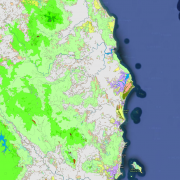
This dataset contains polygons depicting vegetation communities of the Wet Tropics Bioregion. Over 250 vegetation types are described using structural and floristic characteristics, and the vegetation communities have been classified using a logical, hierarchical framework.
At a broad level, the vegetation includes the rainforests, forests and woodlands, sclerophyll rainforests, shrublands and heathlands, herblands and mangrove communities distributed throughout the bioregion.
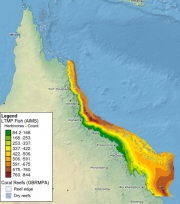
The eAtlas delivers its mapping products via two Web Mapping Services, a legacy server (from 2008-2011) and a newer primary server (2011+) to which all new content it added. This record describes the legacy WMS. This service was decommissioned on in Jan 2024.
The project will assist decision-makers to more efficiently restore biodiversity to degraded rainforest landscapes by providing new knowledge about the outcomes of lower-cost natural regeneration (including potential for minimum intervention management) relative to higher-cost active reforestation (replanting) on post-agricultural land. The outcomes of this project will enable planners to assess the costs, risks and benefits of different approaches to reforestation and choose the most appropriate method for any particular ecological and economic context.
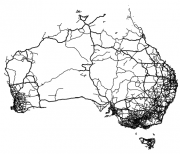
This dataset contains the major roads for Australia, extracted from the OpenStreetMap project on December 2011 by CloudMade.
From the complete set of roads in the OpenStreetMap shapefile only major roads were extracted. This created a smaller high performance shapefile.
In ArcMap loaded the AU_CloudMade_OpenStreetMap-Dec-2011 shapefile then used the Analysis Tools/Extract/Select tool to extract the major roads.
Input Feature Class: australia_highway.shp
Output Feature Class: AU_OSM_MajorRoads.shp
This project involved working with a range of stakeholders to identify the most effective governance systems for managing climate change adaptation in the Wet Tropics through the emergence of new ecosystem service markets, including Carbon Farming. The project will directly contribute to: Regional climate change adaptation policies and planning processes, Regional Natural Resource Management (NRM) organisations’ role in guiding emerging carbon markets in Australia and the region.
This project developed:
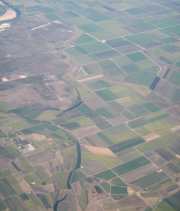
This dataset corresponds to the polygon digitisation of tourism sites and sugar mills. The locations of the tourism sites were obtained from a commercial database of tourism operators (Australian Tourism Warehouse). The location of sugar mills was obtained from information gathered on the internet and point locations were created for each mill. These datasets were developed to fill in missing source datasets for the scenario modelling used for the coastal development modelling.
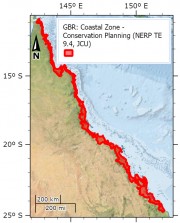
This dataset contains the extent of the coastal zone for the Great Barrier Reef. This extent was identified as the most suitable area to be investigated on land and at sea as part of a conservation planning project looking at coastal development along the GBR coast.
Methods:
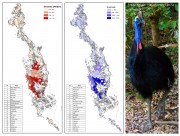
This dataset contains the estimated distribution and abundance of cassowaries across the Wet Tropics Region and the sub-regions used in these estimates. The key areas for cassowary conservation are those with the highest densities and abundance.
This data is based on field surveys and data on cassowary density derived from faecal-DNA analysis of dung samples collected during those surveys.
Methods:
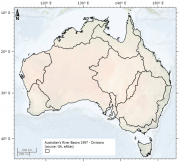
This dataset is derived from the Australia's River Basins 1997 (GA) dataset. It shows the 12 drainage divisions. Primary credit should be given to Geoscience Australia.
This dataset was created by using ArcMap to dissolve polygons from the Australia's River Basins 1997 shapefile based on the DNAME attribute.
The Wet Tropics World Heritage Area (WTWHA) is famous for its wildlife, biodiversity and natural beauty, but none of these important assets are bought or sold in the market place, so none are explicitly ‘valued’ with a price. Recognising that absence of price does not mean absence of value, this project seeks to improve our understanding of the importance of these non-market ‘values’ to a variety of different stakeholders. How important is a beautiful view or a cassowary to the community, to tourists and to the tourism industry?
The low-lying islands of the Torres Strait are vulnerable to climate change and the region faces a range of pressures including a growing population, future climate change, potential pollution as a result of rapid mining and resources development in Papua New Guinea, and increased shipping. Through participatory scenario planning with Torres Strait and PNG communities and stakeholders, informed by integrated ecosystem and climate modelling this project will identify ‘best bet’ strategies to protect livelihoods and achieve sustainable economic development. Tasks include:
Long-term social and economic monitoring helps reef managers understand the current status of marine park users, industries and communities. It also helps build a picture of how industries and communities are likely to respond and cope with changes associated with environmental degradation, climate change, regulatory frameworks, and changes in culture.
This project focuses on understanding the current and future risks and responses of invasive species in the Wet Tropics. The aim is to develop a strategic approach to pest management that considers the complexity of ecological processes involved with establishment and spread and takes account of the values and assets in the region. The project will contribute to the management of invasive plants and animals by providing prioritisation tools that align with existing regional pest management frameworks.



